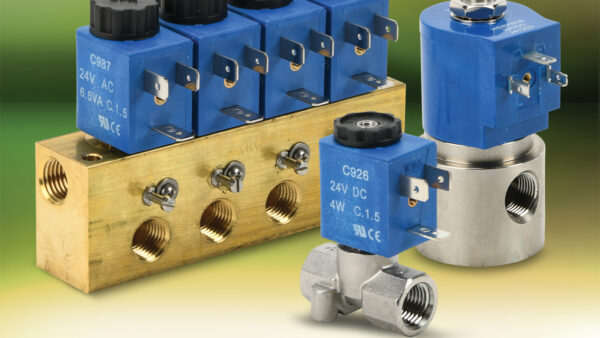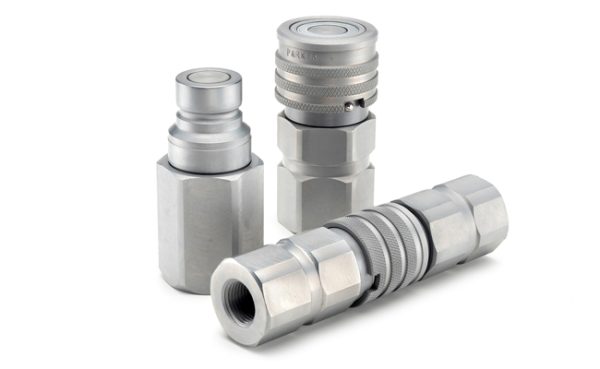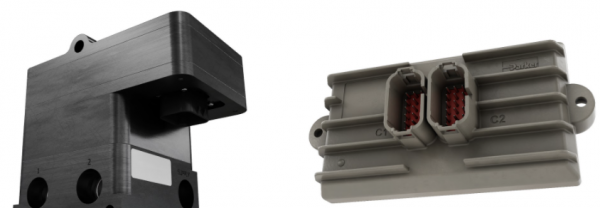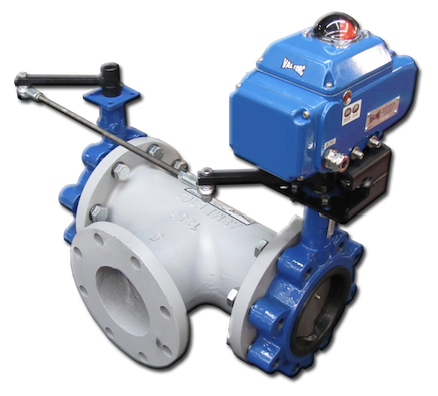Auto-Dock Systems: The Future is Now
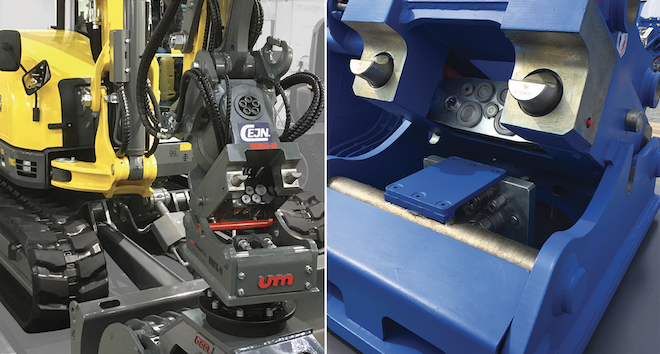
Advances in hydraulic connection technology are positively impacting mobile machinery and tool and attachment design. Increased demands for worksite productivity and efficiency have challenged manufacturers of machines, attachments, and components. One of the resulting advances has been the auto-dock system.
What is an auto-dock system, and what is causing demand for it? We can better understand by looking at the evolution of hydraulic quick connects.
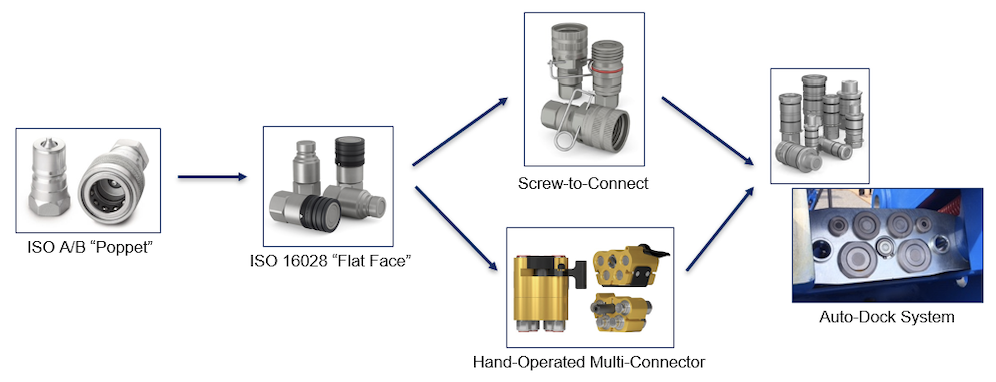
ISO A/B “Poppet” Quick-Connect Coupling
The ISO A/B poppet quick-connect coupling is often termed the general-purpose quick connect. Its basic design was offered an economical means to connect and disconnect hydraulic lines between machines and tools or attachments. This basic coupling has been in use for more than 50 years.
ISO 16028 “Flat Face” Quick-Connect Coupling
The ISO 16028 flat-face quick-connect coupling met the demand for a no-spill non-drip quick disconnect and easier “one-handed” connection to eliminate oil loss and reduce contamination to the hydraulic system. Eventually, a residual pressure elimination nipple was introduced to ease concerns with difficulty in connecting attachments from thermal expansion.
Screw-to-Connect Coupling
The advancement of heavier duty machines increased concerns with vibration damage and surge flow issues. A screw-to-connect coupling allowed a quick break for heavier duty equipment while withstanding the difficult application effects of vibration and surge flows, helping to reduce and eliminate failures when using previous quick connect designs.
Hand-Operated Multiconnector System
As multiple hydraulic functions were incorporated into machinery, it increased the amount of hose routing connections. The challenges were to reduce overall envelope size, eliminate cross-connection, residual pressure issues, and save connection and disconnection time. Hand-operated multiconnectors achieved these goals and opened up acceptance toward auto-connectors.
Today’s Auto-Dock System
This latest technological advancement, an auto-dock system, allows an operator to change tools or attachments without leaving the cab. This occurs by incorporating fit plates and blocks, hydraulic cylinders and locking mechanisms, guide assistance, and electrical cab controls into a single configuration at the point between machinery and tools or attachments. An auto-dock system completely connects or disconnects all hydraulic lines, electrical connections, water lines, air lines, and so on simultaneously. This type of system greatly reduces downtime between tool and attachment changes to 10-20 seconds, as opposed to the more traditional 5-10 minutes. An auto-dock system also helps eliminate issues related to cross-connection (user error of connecting or disconnecting lines) and helps eliminate “hanging components” that may accidentally be damaged in tight work places (e.g., snagging a hose in close quarters on rebar or rubbing hoses against concrete).
Over the last 10-plus years, companies have offered aftermarket auto-dock systems for small and medium-sized machinery, mainly geared for small-business implementation. As mobile machinery and tool and attachment manufacturers have realized the values of an auto-dock system (by customer demand for improved overall savings), they are beginning to include them in new models.
Larger OEM’s have also begun offering auto-dock systems bundled with common tools and attachments, providing professional users with a multifunction machine with greater capabilities at each jobsite. Auto-dock systems are popular in the demolition and recycling industries (any site involving cleanup and that uses many tools and attachments), but there is value in many mobile applications and industries. As each manufacturer develops capabilities using auto-dock systems, the systems revolutionize other mobile industries, similar to the influences of previous quick-connect technologies.
There are two auto-dock systems presently in use: horizontal and vertical connection. Thus far, the vertical connection system has been better received; it improves the lifespan of auto-dock connections and offers greater protection from dirt, debris, and other environmental conditions.
A key consideration is the frequency of tool or attachment changeouts. If an operator frequently changes a specific group of tools or attachments each day, this is an ideal target that should be evaluated for time-loss reductions with an auto-dock system. An important question often asked by fleet and site managers is how much equipment and personnel are required for each job. If a machine typically uses the same four or five attachments, or several machines share a group of tools and attachments (depending on the size of the job), it’s possible to increase productivity with an auto-dock system that frees up valuable inventory and personnel for additional work sites.
Another element to auto-dock systems is the consistency of design and usage. This is especially important when it comes to wear and tear on components used in mobile machinery. Logically, an auto-dock system allows operators more consistent conditions between connection and disconnection changeout needs. Removing unnecessary variables (including user inconsistencies), helps improve the overall life of componentry in this connection-point system. The addition of sensors and other safety aspects also helps redirect maintenance from reactive to proactive, including a desired predictive maintenance schedule.
The technology shift is quickly bringing value to mobile machinery industries. Once the investment is made, the professional fleet is able to quickly identify its ROI. It allows professional machine operators to work more effectively at each jobsite while allowing fleet and site managers to better plan and accommodate more jobs.
From a manufacturing standpoint, OEM’s can capitalize on advancing technology while meeting customer demands for improved productivity and efficiency. As auto-dock systems are used more often in the mobile machinery industries, the technology should strategically provide additional business opportunities when compared to companies reluctant to adopt new ideas and principles.
Should you consider an auto-dock system? Take the quiz to find out!
- Does your team or your customers have machines that frequently change tools or attachments each work day?
- Have your teams or customers experienced issues related to a forgotten connection (e.g., hydraulic, electrical, water, air) during tool or attachment changeouts?
- Do your teams or customers often deal with damaged hose assemblies from hanging hoses in confined work areas?
- Have your managers or customers complained about effectively sharing machinery between job sites?
- Do your teams or customers often dedicate specific tools or attachments to specific machines?
- Would your teams or customers be interested in reducing maintenance costs between machines and tool or attachments?
- Are your teams or customers weighing additional machines and tool or attachments purchases versus trying find ways to maximize usage with their existing fleet?
If you answered “yes” to any of these questions, learn more about how auto-dock system technology can work for you.
To learn more, visit https://www.cejn.com.

